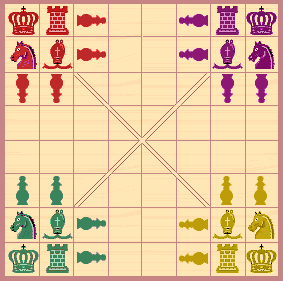

Shatranj for four players originated in India during the Muslim era. It was mostly played without dice, and generally with stakes involved. The four players play by themselves (although informal alliances are possible). The green army was associated with spring, element air, and humour blood. Red was associated with summer, element fire, and humour choler. Black was associated with autumn, element earth, and humour melancholy. White was associated with winter, element water, and humour phlegm.
The king, rook, knight, and queen (the queen appears only after promotion), move as in orthodox chess. Pawns, too, move as in orthodox chess, but have no initial double move. There are two sets of pawns for each player that move in different directions. Pawns promote to queen only. The fil jumps two squares diagonally. Kings can be captured. The player whose king remains alone on the board wins the game. A player that captures an enemy king appropriates his pieces.
One mustn’t thoughtlessly exchange pieces with an opponent because this will leave the other two players with piece majorities. Remember that the Fil is a quite weak piece that could be sacrificed for a pawn, if this will strengthen the attack.
Discussion
Murray (1913, p.349), gives bishops in the setup position. However, this is not possible because piece exchanges would immediately ensue, and this would make the game futile. I contend that it’s not a bishop, but a fil (boat), i.e., a much weaker piece that can jump two steps diagonally. During this era in India the fil was still in use (and still is, in some parts of the world). Murray says that when a player was mated he fell out, and his pieces were appropriated by his conqueror. But it’s not plausible that he would continue with two kings. Therefore, instead of checkmate, I believe that king capture is more logical.
When the pieces are appropriated this program will change the pieces’ colour, something which didn’t occur in reality, but which facilitates the identification of the pieces. The cross in the middle of the board served the purpose of reminding the players of the movement-direction of the pawns. But as the pawns in this program are projected in the movement direction the confusing pawn movement rules won’t cause any problem. I also think that 4-handed Shatranj is a better name than 4-handed chess, as this is not sufficiently alike modern chess. I believe that this game was developed as the older 4-handed Chaturanga was only suitable for playing with dice. 4-handed Shatranj works very well without dice.
References
Murray, HJR (1913). A History of Chess. Oxford: At the Clarendon Press.
You can download my free 4-handed Shatranj program here (updated 2009-12-12), but you must own the software Zillions of Games to be able to run it.
© Mats Winther 2006